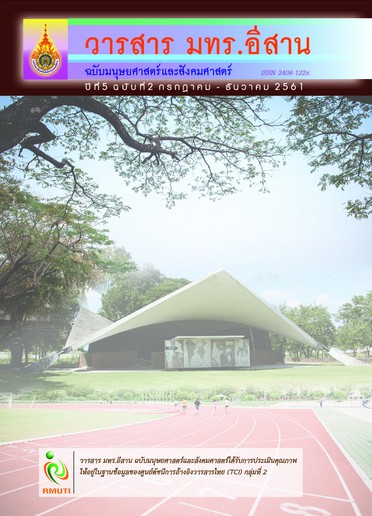Factors Associated with Happiness of Junior Secondary Students in Demonstration Secondary School, Srinakharinwirot University
Main Article Content
Abstract
The purposes study were to study happiness and factors associated with happiness of junior secondary students in Demonstration Secondary School, Srinakharinwirot University (SWU). The sample were 300 junior secondary students (aged 12 - 15) from the Demonstration Secondary School, SWU. They were selected 10 simple randomly classrooms, each classroom with 30 students. The research instruments were factors associated with happiness questionnaire and the Oxford Happiness Questionnaire. Data were analyzed by frequency, percentage, mean, standard deviation, chi-square and logistic Regression Analysis. The results revealed that the mean score of self-happiness students was 4.31, indicating that happiness was at a high level. When it was compared to the criteria of the Mental Health Department, 89.0 percent of the students had a normal level of happiness. Whereas 11.0 percent had less happiness than the average person. Factors associated to happiness were accumulative grade point average, marital status of father-mother, leadership style personality and good relationship with friends could be aff ected to the chances of lower happiness 36.10 % at the statistical signifi cance level of 0.05. There was no statistically signifi cant diff erence in parental-occupational, gender, residential, the amount of monthly expenses, family living with parents, people getting help and advising, having a good relationship with the family and having a good relationship with the teacher. The results of the study are helpful in planning and setting the program to promote happiness of students.
Article Details
บทความที่ได้รับการตีพิมพ์เป็นลิขสิทธิ์ของมหาวิทยาลัยเทคโนโลยีราชมงคลอีสาน
ข้อความที่ปรากฏในบทความแต่ละเรื่องในวารสารวิชาการเล่มนี้เป็นความคิดเห็นส่วนตัวของผู้เขียนแต่ละท่านไม่เกี่ยวข้องกับมหาวิทยาลัยเทคโนโลยีราชมงคลอีสานและคณาจารย์ท่านอื่นๆในมหาวิทยาลัยฯ แต่อย่างใด ความรับผิดชอบองค์ประกอบทั้งหมดของบทความแต่ละเรื่องเป็นของผู้เขียนแต่ละท่าน หากมีความผิดพลาดใดๆ ผู้เขียนแต่ละท่านจะรับผิดชอบบทความของตนเองแต่ผู้เดียว
References
เกสร มุ้ยจีน. (2559). การสร้างความสุขด้วยจิตวิทยาเชิงบวก. วารสารวิทยาศาสตร์และเทคโนโลยี. ปีที่ 24, ฉบับที่ 4, หน้า 673-681
ขวัญจิต มหากิตติคุณ, พิเชษฐ์ สุวรรณจินดา, และวีณา คันฉ้อง. (2559). ความสุขของนักเรียนวัยรุ่น. วารสารพยาบาลสงขลานครินทร์. ปีที่ 36, ฉบับที่ 1, หน้า 87-97
เรวดี เพชรศิราสัณห์, ศิริอร สินธุ, สายฝน เอกวรางกูร, อุไร จเรประพาฬ, และเจนเนตร พลเพชร. (2550). ความสุขและวิถีการสร้างเสริมสุขภาพ: ความต้องการที่แตกต่างระหว่างคนสามวัยในครอบครัวไทย. วารสารพยาบาล. ปีที่ 56, ฉบับที่ 1-2, หน้า 11-12
รศรินทร์ เกรย์, วรชัย ทองไทย และเรวดี สุวรรณนพเก้า. (2553). ความสุขเป็นสากล. กรุงเทพฯ จรัลสนิทวงศ์การพิมพ์
ลัดดาวัลย์ ธีรภาพชัยศรี. (2554). ความสุขในนักเรียนมัธยมศึกษา. เอกสารการประชุมวิชาการสุขภาพจิตนานาชาติครั้งที่ 10 และการประชุมวิชาการพัฒนาสติปัญญาเด็กไทย ครั้งที่ 8 ประจำปี 2554. หน้า 254. Available (http://www.jvkk.go.th/researchnew/qrresearch.asp?code=0103502)
วรรัตน์ กัจฉมาภรณ์, กิตติพงษ์ ดงแสง, กุลญาดา สมทรัพย์, ฐปนวงศ์ มิตรสูงเนิน, ทศพล อารีจิตรานุสรณ์, ปิยธิดา คูหิรัญญรัตน์, และศรีนอ้ ย มาศเกษม. (2550). ระดับความสุขและปัจจัยที่เกี่ยวข้องของนักเรียนมัธยมศึกษาตอนปลาย โรงเรียนขอนแก่นวิทยายน จังหวัดขอนแก่น ปีการศึกษา 2549. ศรีนครินทร์เวชสาร. ปีที่ 22, ฉบับที่ 3, หน้า 254-260
วิเชียร เกตุสิงห์. (2538). ค่าเฉลี่ยและการแปลความหมาย. ข่าวสารวิจัยทางการศึกษา. ปีที่ 18, ฉบับที่ 3, หนา้ 8 - 11
ศิรินันท์ กิตติสุขสถิต. (2551). ความสุขของวัยรุ่น, ประชากรและการพัฒนา. สถาบันวิจัยประชากรและสังคม มหาวิทยาลัยมหิดล. ปีที่ 28, ฉบับที่ 3, Available (http://www.popterms.mahidol.ac.th/newsletter/showarticle.php?articleid=67)
Brislin, R.W. (1970). Back-Translation for Cross-Cultural Research. Journal Cross-Cult Psychology. Vol. 1, Issue 3, pp. 185-216. DOI: 10.1177/135910457000100301
Conbach, L. J. (1984). Essential of Psychology and Education. New York: Mc-Graw Hill
Gray, R. S., Chamratrithirong, A., Pattaravanich, U., and Prasartkul, P. (2013). Happiness Among Adolescent Students in Thailand: Family and Non-Family Factors. Social Indicator Research. Vol. 110, No. 2, pp. 703-719
Green, L. and Krueter, M. (1999). Health Program Planning: An Educational and Ecological Approach. Bostion: McGraw-Hill. Available (https://www.gotoknow.org/posts/115416)
Heizomi, H., Allahverdipour, H., Jafarabadi, M. A., and Safaian. A. (2015). Happiness and Its Relation to Psychological Well-Being of Adolescents. Asian Journal of Psychiatry. Vol. 16, pp. 55-60. DOI: 10.1016/j.ajp.2015.05.037
Hills, P. and Argyle, M. (2002). The Oxford Happiness Questionnaire: A Compact Scale for the Measurement of Psychological Well-Being. Personality and Individual Diff erences. Vol. 33, Issue 7, pp. 1071-1082. DOI: 10.1016/S0191-8869(01)00213-6
Holder, M. D., Coleman, B., and Singh, K. (2012). Temperament and Happiness in India. Journal of Happiness Studies. Vol. 13, Issue 2, pp. 261-274. DOI: 10.1007/s10902-011-9262-x
Kok, J. K., Goya, L. Y., and Gan, C. C. (2015). Meaningful Life and Happiness: Perspective from Malaysian Youth. The Social Science Journal. Vol. 52, Issue 1, pp. 69-77. DOI: 10.1016/j.soscij.2014.10.002
Krejcie, R. V. and Morgan, D. W. (1970). Determining Sample Size for Research Activities. Education and Psychological Measurement. Vol. 30, Issue 3, pp. 607-610
Liaghatdar, M. J., Jafari, E., Abedi, M. R., and Samiee, F. (2008). Reliability and Validity of the Oxford Happiness Inventory among University Students in Iran. The Spanish Journal of Psychology. Vol. 11, Issue 1, pp. 310-313. DOI: 10.1017/S1138741600004340
Mehrdadi, A., Sadeghian, S., Direkvand-Moghadam, A., and Hashemian, A. (2016). Factors Aff ecting Happiness: A Cross-Sectional Study In The Iranian Youth. Journal of Clinical and Diagnostic Research. Vol. 10, Issue 5, pp. VC01-VC03. DOI: 10.7860/JCDR/2016/17970.7729
Uusitalo-Malmivaara, L. (2014). Happiness Decreases During Early Adolescence-A Study on 12-And 15-Year-Old Finnish Students. Psychology. Vol. 5, No. 6, pp. 541-555. DOI: 10.4236/psych.2014.56064


